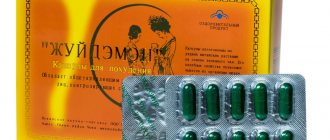Taurine is an amino acid containing sulfur. Necessary for fat metabolism, serves as a neurotransmitter in the central nervous system. It comes from food of animal origin and is independently synthesized in the body; with a lack of the substance, various health problems arise.
How the substance is used in ophthalmology, we will consider in this article.
Description of the drug
In the treatment of diseases of the organs of vision associated with dystrophic changes or a sharp failure in the metabolism of eye tissue, the drug Taurine in the form of a solution is actively used.
The medicine is available in 5 ml or 10 ml bottles, 1 ml contains 40 mg of taurine. The minor components are 1 mg of methyl parahydroxybenzoate and 1 ml of water for injection. The composition is a transparent liquid substance without color.
In pharmacy chains and on the Internet you can buy Taurine from different manufacturers, both in glass bottles with rubber stoppers and in bottles with a dropper for easy instillation. The drug is packaged in cardboard boxes along with instructions.
The role of taurine in the correction of carbohydrate metabolism disorders
Abdominal obesity plays an important role in carbohydrate metabolism disorders. Against this background, leptin and insulin resistance arise and progress. This leads to changes in the production of free fatty acids and the development of chronic oxidative stress. The situation is aggravated by amino acid imbalance, which is associated with decreased levels of taurine in blood plasma and tissues. Therefore, taurine can be used in patients with impaired carbohydrate metabolism. The drug is able to have a positive effect on the pathogenesis of insulin resistance both at the level of adipose tissue and at the liver level.
Rice. 1. Formation of taurine from the sulfur-containing amino acid cysteine
Rice. 2. Effects of taurine
Table 1. Average values of leptin, insulin, HOMA-IR, TG in the study groups
Table 2. Average values of BMI, WC and TB while taking Dibikor in the study groups
Table 3. Average values of leptin, insulin, HOMA-IR, TG while taking Dibikor in the study groups
Introduction
An important role in carbohydrate metabolism disorders (CAM) is played by a change in the ratio of fat and muscle tissue towards the former. This leads to the development of abdominal obesity, which is accompanied by changes in leptin metabolism. A decrease in the physiological effects of leptin is associated with a decrease in antilipotoxic effects, glucose elimination, and an increase in hepatic glucose production. Thus, insulin resistance (IR) develops and progresses. Under IR conditions, the regulation of the concentration of free fatty acids in the blood plasma occurs. With chronically elevated levels of free fatty acids, oxidative stress is triggered and cells cease to adequately respond to the action of insulin. Excess visceral adipose tissue is associated with a pathologically increased entry of proinflammatory cytokines into the bloodstream, which leads to disruption of homeostasis in adipocytes and increased lipolysis.
The balance of adipose tissue is influenced by factors such as lifestyle (taking into account the chronobiological hours of wakefulness and sleep), stress, nutrition and physical activity. It should be noted that in recent decades, the population’s diet has seen a predominance of fast carbohydrates and refined fats over proteins. It has been established that an excess of fast carbohydrates causes the development of leptin resistance and an increase in triglyceride (TG) levels, while protein deficiency causes an imbalance of amino acid composition. This in turn leads to disruption of metabolic processes [1]. Protein restriction in the diet can cause hyperphagia by activating leptin resistance through the hypothalamic axis [2]. Consumption of foods high in refined fats impairs lysosomal function of adipocytes, which exacerbates IR and oxidative stress [3].
According to a number of authors, under conditions of amino acid imbalance, the predominance of lipolysis in adipocytes, and the progression of insulin and leptin resistance, the level of taurine decreases both in the blood plasma and in tissues.
Taurine is a vital sulfoamino acid, which is the end product of the metabolism of sulfur-containing amino acids (cysteine, methionine, cysteamine) (Fig. 1).
The functions of taurine in the body are varied. It is known that, by combining with cholic acid, taurine affects the absorption of fats and fat-soluble vitamins. When combined with chlorine, it acts as an oxidizing agent and a component of antibacterial protection. In chloramine mitochondria, taurine affects the assembly of respiratory chain proteins and has an antioxidant effect. In its free state, taurine regulates osmotic pressure. In addition, it is involved in the regulation of bile secretion. Tauroconjugates of bile acids have a choleretic effect and prevent the development of cholestasis [4]. Taurocholic acid reduces Escherichia coli
in the cecum. Taurine reduces the content of waste products of microorganisms in the colon (short-chain fatty acids, endotoxin, nitric oxide) [5]. In patients with type 2 diabetes mellitus (DM), taurine improves IR. On the one hand, it modulates insulin production - regulates insulin secretion through its influence on the level of intracellular calcium, on the other hand, it participates in the implementation of the insulin signal - increases the sensitivity of receptors to insulin [6–8]. In addition, taurine has been proven to have a positive effect on endothelial dysfunction, diabetic retinopathy and diabetic foot syndrome.
It has been established that in patients with microangiopathy the concentration of taurine in the blood is reduced. Therefore, some authors propose using it as a marker for the early diagnosis of microangiopathies in patients with diabetes [9, 10].
The mechanisms of action of taurine are presented in Fig. 2.
Purpose
Our study was to evaluate the role of taurine in the correction of carbohydrate metabolism in patients with early disorders of carbohydrate metabolism and type 2 diabetes.
Material and methods
A retrospective analysis of the charts of patients with obesity and carbohydrate metabolism disorders of varying degrees, as well as without carbohydrate metabolism disorders, was carried out. 20 people were selected with early disorders of carbohydrate metabolism (ECD group), with type 2 diabetes lasting up to five years - 20 (DM group), without disturbances of carbohydrate metabolism - 20 patients (control group).
Anthropometric indicators were analyzed: waist circumference (WC), hip circumference (HC), height and body weight to calculate body mass index (BMI), as well as fasting plasma glucose (FPG), glycated hemoglobin (HbA1c), leptin, insulin, index homeostatic model for assessing insulin resistance (Homeostasis Model Assessment of Insulin Resistance - HOMA-IR), triglycerides (TG). The level of HbA1c was studied using high-performance liquid chromatography (Bio-Rad D10, USA), leptin - enzyme-linked immunosorbent assay, immunoreactive insulin (IRI) - radioimmunoassay (BIOSEN C-Line, Germany). HOMA-IR values were calculated using the formula: IRI × FPG: 22.5.
Written informed consent for data processing was obtained from all study participants.
To compare samples, the nonparametric Kruskal–Wallis variance test, Spearman's rank correlation coefficient, and multiple linear regression analysis were used. The critical value for the significance of the results was taken to be 0.05. Mathematical data processing was carried out using SPSS Statistics 22.0, Statistica 6.0.
Results and its discussion
The average age of patients in the groups was 54.50 ± 5.04 years. 75% of study participants are women.
All patients suffered from first degree obesity (according to the 1997 World Health Organization classification). Thus, BMI in the control group was 31.35 ± 5.85 kg/m2, in the RNU group - 32.70 ± 5.12 kg/m2, in the DM group - 33.21 ± 6.12 kg/m2, WC - 96.65 ± 8.53, 98.75 ± 16.49 and 104.05 ± 5.69 cm, OB – 92.00 ± 21.89, 112.00 ± 18.91 and 114.42 ± 7.76 cm respectively. Average FPG level – 4.96 ± 0.46, 5.34 ± 0.48 and 6.89 ± 1.34 mmol/l, HbA1c – 5.57 ± 0.45, 6.07 ± 0.53 and 6 .27 ± 1.34%, respectively. The values of leptin, insulin, HOMA-IR, TG are presented in table. 1.
Patients in the control group and RNOO were on a low-carbohydrate diet. Patients with type 2 diabetes took an oral hypoglycemic drug from the biguanide group and a lipid-lowering drug from the statin group. In order to better correct carbohydrate metabolism and triglyceride levels, patients were prescribed taurine (Dibikor). Dosage regimen: 500 mg twice a day for three months. After this period of time, BMI in the groups decreased on average by 3.5%, WC - by 13.4%, OB - by 10.3% (Table 2).
The average HbA1c level in the groups was 4.50 ± 0.35, 5.6 ± 0.42, 6.01 ± 1.23%, respectively. The level of leptin decreased by 3.96%, insulin - by 30.5%, HOMA-IR value - by 0.9%, TG - by 1.54% (Table 3).
Conclusion
According to the results obtained, in all groups, taurine helped reduce leptin and insulin resistance by reducing the volume of visceral fat and reducing TG levels. Consequently, Dibicor can be used for varying degrees of carbohydrate metabolism disorders to influence the mechanisms of development of IR both at the level of adipose tissue and at the level of the liver.
How does Taurine work?
It has been established that the substance is present in all tissues of the human body, but most of all it is found in the heart muscle and eye tissues, especially in the retina. It was also found in the optic nerve.
If the body is deficient in taurine, then it is likely to develop severe degenerative damage to the retina, as well as age-related cataracts.
The functioning of the visual organs depends on the quality of metabolic processes, which deteriorates with age. To restore metabolism and speed it up, Taurine drops are used topically.
The therapeutic effect of the drug is achieved due to the action of the main substance, which:
- normalizes the function of plasma membranes;
- stimulates tissue restoration;
- activates metabolic and energy processes;
- improves the conduction of excitation waves along nerve fibers;
- promotes the accumulation of potassium and calcium ions, therefore, preserves the electrolyte composition of the cytoplasm;
- stabilizes protein and carbohydrate metabolism.
The drops provide antioxidant protection to the lens from damage due to oxidation, which causes age-related changes in eye tissue and the development of cataracts, even in diabetes mellitus with high blood glucose levels.
Food Sources of Taurine
The main source of taurine for humans is food , since its production in the body is very small. Thus, your supplement needs are closely related to your diet. Natural food sources of taurine include [12]:
- meat
- seafood – oysters, mussels and shrimp
- seaweed
It follows that vegetarians and vegans in particular suffer from taurine deficiency . The average daily intake of taurine from food is as follows [12]:
- in people who eat meat – 123 mg
- vegetarians who eat eggs and dairy products – 17 mg
- vegans – 0 mg
The taurine content in breast milk also depends on the mother's lifestyle. Women who eat mostly everything have 1.5 times more taurine in their milk than vegetarian mothers .[13]
For what diseases are Taurine drops prescribed?
According to the instructions for use of Taurine, drops are prescribed for:
- gradual death of retinal cells of the organs of vision (including with hereditary pigmentary degenerations, corneal dystrophies);
- clouding of the lens (that is, cataracts caused by injury, old age, radiation therapy, diabetes);
- corneal injuries (to start the healing process).
Taurine is prescribed both for medicinal purposes and to prevent the progression of myopia and farsightedness.
Drops relieve spasms of accommodation, normalize blood circulation in tissues, improve retinal nutrition, reduce eye pressure and reduce the risk of complications.










